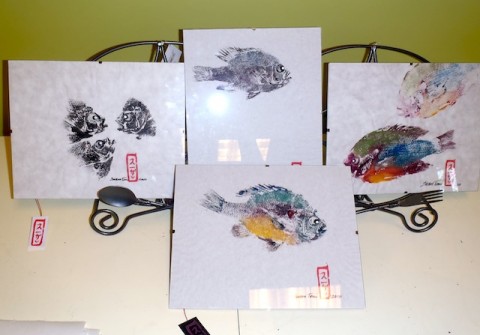Art remains on display for the next two weeks.

 ???Learning Gyotaku printing seemed to be the natural path to take as an artist because I have spent the summer after graduating from Austin Peay University camping and fishing. I rediscovered how much I enjoy fishing at Land between the Lakes a place that conveniently close and with abundant fish.
???Learning Gyotaku printing seemed to be the natural path to take as an artist because I have spent the summer after graduating from Austin Peay University camping and fishing. I rediscovered how much I enjoy fishing at Land between the Lakes a place that conveniently close and with abundant fish.
Gyotaku is a traditional form of Japanese fish printing dating from the mid 1800’s It was used as a way to record ones fish catch by fisherman who wanted to produce proof of their specimens in the days before cameras. I guess you could say that even way back then to a fisherman your catch is just a fish story unless you can produce a image. All of the Gyotaku prints are unique in that it is impossible to make an exact duplicate even using the same fish. The authentic use of real fish is proven with just one sniff of my rice paper prints. Since I use non-toxic inks, the fish end up on our dinner plates, giving their lives to both art and sustenance.

My woodblock prints of my Father in law and the Okra provided hours of quiet meditation as I carved each woodblock. My Father in law has been seriously ill and it meant a lot to me that he posed for me in his summer hat. I love him very much. The Okra is one of the most hardy of plants in my garden, even surviving my novice green thumb skills. There is something so gratifying in growing your own food, a joy I hope I captured carving and printing the okras image.
The linoleum prints of Sushi, udon and various Japanese dishes reveal my insatiable love of Asian food. There is nothing like sharing a cup of green tea while eating sushi with a friend.
All of these forms of printing, Gyotaku, woodcut and linoleum require no machinery. I simply use palm gouges to carve and a simple wooden spoon as my press. While the gift of printing was given to me by Professors Cindy Marsh and Jesse Shaw, the Gyotaku study involved research, trial and error to produce fish prints that were amusing and delightful records of a days catch.
Creating this body of work gave me hours to reflect on my Okinawan ancestry. I felt strangely connected to my mothers home as I listened to Ikue Asazaki singing Okinawan folk songs. I could almost feel my Grandmother standing over me as I respectfully acknowledged her influence and culture.


